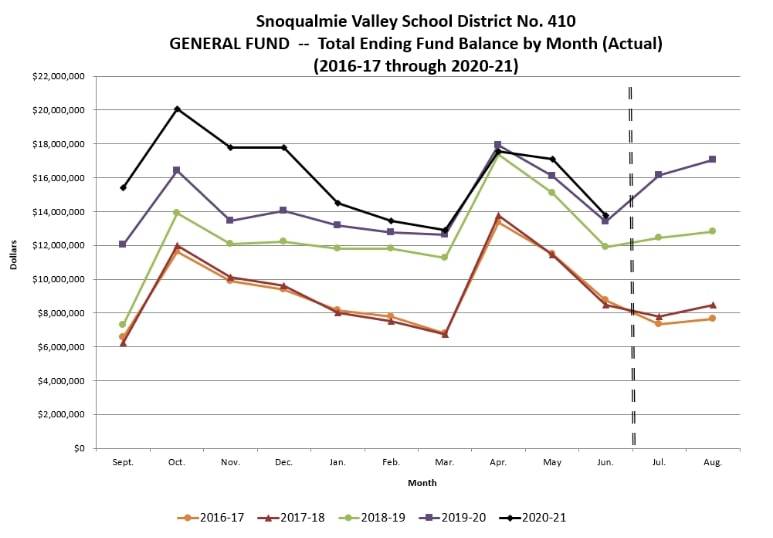The Snoqualmie Valley School District expects to run a budget deficit this year, but district officials are not overly concerned.
This is according to Ryan Stokes, the assistant superintendent of finance and operation for the district, who gave a report on the budget at the district’s school board meeting Aug. 12.
The district is projected to spend about $3.2 million more than it brings in this year. Compared to the 2020-2021 budget, the district expects to receive about $1 million less in revenue, while spending an additional $3 million.
According to Stokes, the district will have to rely on $1.8 million in general fund reserves to balance the 2021-2022 budget. The district also relied on the general funds during the 2020-2021 school year, when the district used $2.2 million to balance the budget.
“Having some draw [from reserves] isn’t terrible, but we do want to balance the budget,” Stokes said. “It’s something we’ll have to monitor going forward.”
Overall, the district’s general fund balance is in a similar place as it was this time last year. Stokes said part of that is due to a supply chain backlog, which delayed transactions on technology and other investments the district had made over the summer.
Stokes said another major component of the general fund’s situation is from one-time fees, which were provided to the district by state and federal agencies to help ease revenue loss during the pandemic.
“It’s a lot of those one-time fees that may not be there next year,” he said.
For example, this year the federal government is using funds to provide free lunches for all students. The district also received Elementary and Secondary School Emergency Relief (ESSER) funding — which was part of the CARES Act — that they are planning to use over the next few years.
The state also chipped in, providing the district with enrollment stabilization funding to account for a decrease in revenue from enrollment decline.
Enrollment has been one of the biggest losses of revenue for the district during the pandemic. In Washington, enrollment is the primary driver that determines how much state funding each district receives.
Projected enrollment for the Snoqualmie Valley School District this year is 4% less than what was projected during the 2020-2021 school year. Overall enrollment has increased 2% since last year, which means enrollment is slightly below pre-pandemic levels.
Stokes said enrollment numbers are also more difficult to predict this year than previously, partially out of parental concerns about the safety of sending kids back to school. He said a lot of the uncertainty surrounds kindergarten students. He also said enrollment could rebound, resulting in additional funds.
Stokes said the district increased spending this year out of the desire to not halt projects already in progress.
The district used additional spending to move forward with waiving some basic class-related fees for secondary students that were required to meet course standards. This includes fees for some music and CTE classes.
“It’s important no fees are associated with what students need,” said Lance Gibbon, superintendent of the district. “There might be a fee for scaling up, but you would do all the necessary projects in the class for free.”
The district also went forward with hiring additional 17 certified staff and 11 classified staff, particularly focusing on the elementary school level. Stokes said the reason behind this was to push forward with the district’s goal to reduce class size and to curb learning losses that were caused by the pandemic.
Stokes said over the next three years, the district expects to have an annual expenditure reduction of about $1 million. He said initial budget reduction should be relatively easy, but could become more challenging over the years. However, he said projections could still change.
School Board President Melissa Johnson said that deficits and budget reduction are not new and are something the district anticipated.
When looking at budget reductions, Stokes said the district would prioritize equity and sharing the reduction across the district. He said any budget cuts will go to things outside the classroom prior to impacting classes. He also said revenues could improve soon.
“This is really a soft forecast,” he said. “Things change year to year, sometimes month to month with what we’re living in.”


